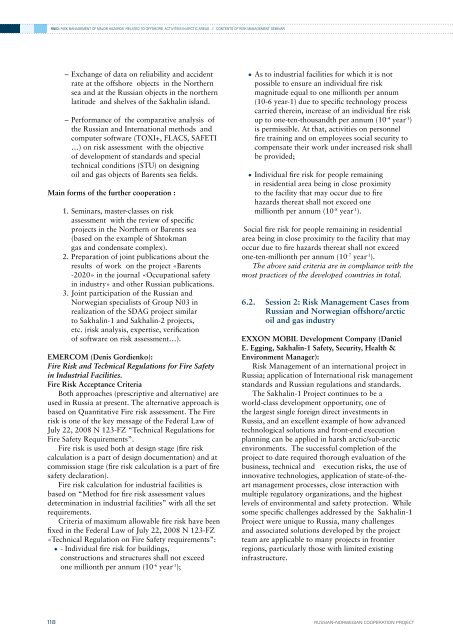phase 4 report - DNV
phase 4 report - DNV
phase 4 report - DNV
Create successful ePaper yourself
Turn your PDF publications into a flip-book with our unique Google optimized e-Paper software.
RN03: RISK MANAGEMENT OF MAJOR HAZARDS RELATED TO OFFSHORE ACTIVITIES IN ARCTIC AREAS // Contents of Risk Management Seminar––Exchange of data on reliability and accidentrate at the offshore objects in the Northernsea and at the Russian objects in the northernlatitude and shelves of the Sakhalin island.––Performance of the comparative analysis ofthe Russian and International methods andcomputer software (TOXI+, FLACS, SAFETI…) on risk assessment with the objectiveof development of standards and specialtechnical conditions (STU) on designingoil and gas objects of Barents sea fields.Main forms of the further cooperation :1. Seminars, master-classes on riskassessment with the review of specificprojects in the Northern or Barents sea(based on the example of Shtokmangas and condensate complex).2. Preparation of joint publications about theresults of work on the project «Barents-2020» in the journal «Occupational safetyin industry» and other Russian publications.3. Joint participation of the Russian andNorwegian specialists of Group N03 inrealization of the SDAG project similarto Sakhalin-1 and Sakhalin-2 projects,etc. (risk analysis, expertise, verificationof software on risk assessment…).EMERCOM (Denis Gordienko):Fire Risk and Technical Regulations for Fire Safetyin Industrial Facilities.Fire Risk Acceptance CriteriaBoth approaches (prescriptive and alternative) areused in Russia at present. The alternative approach isbased on Quantitative Fire risk assessment. The Firerisk is one of the key message of the Federal Law ofJuly 22, 2008 N 123-FZ “Technical Regulations forFire Safety Requirements”.Fire risk is used both at design stage (fire riskcalculation is a part of design documentation) and atcommission stage (fire risk calculation is a part of firesafety declaration).Fire risk calculation for industrial facilities isbased on “Method for fire risk assessment valuesdetermination in industrial facilities” with all the setrequirements.Criteria of maximum allowable fire risk have beenfixed in the Federal Law of July 22, 2008 N 123-FZ«Technical Regulation on Fire Safety requirements”:• - Individual fire risk for buildings,constructions and structures shall not exceedone millionth per annum (10 -6 year -1 );• As to industrial facilities for which it is notpossible to ensure an individual fire riskmagnitude equal to one millionth per annum(10-6 year-1) due to specific technology processcarried therein, increase of an individual fire riskup to one-ten-thousandth per annum (10 -4 year -1 )is permissible. At that, activities on personnelfire training and on employees social security tocompensate their work under increased risk shallbe provided;• Individual fire risk for people remainingin residential area being in close proximityto the facility that may occur due to firehazards thereat shall not exceed onemillionth per annum (10 -8 year -1 ).Social fire risk for people remaining in residentialarea being in close proximity to the facility that mayoccur due to fire hazards thereat shall not exceedone-ten-millionth per annum (10 -7 year -1 ).The above said criteria are in compliance with themost practices of the developed countries in total.6.2. Session 2: Risk Management Cases fromRussian and Norwegian offshore/arcticoil and gas industryEXXON MOBIL Development Company (DanielE. Egging, Sakhalin-1 Safety, Security, Health &Environment Manager):Risk Management of an international project inRussia; application of International risk managementstandards and Russian regulations and standards.The Sakhalin-1 Project continues to be aworld-class development opportunity, one ofthe largest single foreign direct investments inRussia, and an excellent example of how advancedtechnological solutions and front-end executionplanning can be applied in harsh arctic/sub-arcticenvironments. The successful completion of theproject to date required thorough evaluation of thebusiness, technical and execution risks, the use ofinnovative technologies, application of state-of-theartmanagement processes, close interaction withmultiple regulatory organizations, and the highestlevels of environmental and safety protection. Whilesome specific challenges addressed by the Sakhalin-1Project were unique to Russia, many challengesand associated solutions developed by the projectteam are applicable to many projects in frontierregions, particularly those with limited existinginfrastructure.118RUSSIAN–NORWEGIAN COOPERATION PROJECT






![Risk Based Pipeline Integrity Management [Compatibility Mode] - DNV](https://img.yumpu.com/50424229/1/190x146/risk-based-pipeline-integrity-management-compatibility-mode-dnv.jpg?quality=85)









